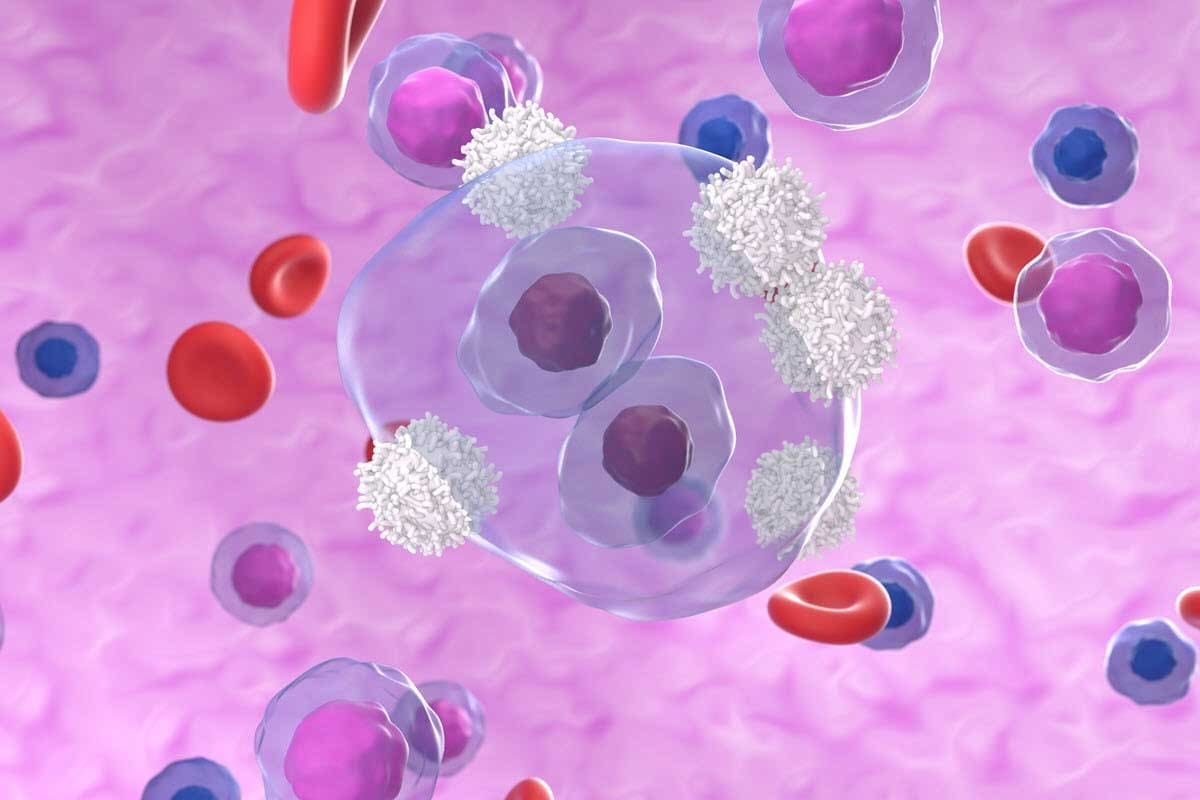Last Updated on November 27, 2025 by Bilal Hasdemir

When someone with cancer hears ‘remission’, they feel hopeful. At Liv Hospital, we know how important this word is. Remission is when cancer symptoms lessen or go away after treatment.
‘In remission’ means symptoms are gone, either fully or partly. Studies show most cancer comes back within five years after treatment. We keep checking on our patients to help them stay healthy.
Key Takeaways
- Cancer remission is a period where symptoms diminish or disappear.
- There are different types of remission, including complete and partial remission.
- Ongoing monitoring is key after treatment ends.
- Remission shows treatment is working well.
- Liv Hospital offers top-notch care and support for patients from abroad.
Cancer Remission Definition in Medical Terms
Remission in cancer treatment has changed a lot over time. This change comes from new medical technology and better understanding of cancer. Simply put, remission means the cancer is controlled, and there are no signs of it. But, figuring out if someone is in remission is complex and depends on many medical factors.
Clinical Criteria for Determining Remission
To see if a patient is in remission, doctors use several tests. These tests differ based on the cancer type. Here are some common ones:
- Imaging Tests: X-rays, MRI scans, and CT scans show the tumor’s size and where it is.
- Blood Tests: Blood tests look for biomarkers that show if cancer cells are there.
- Biopsies: Tissue samples are checked under a microscope to see if cancer cells are present.
These tests help doctors decide if a patient’s cancer is in remission. What counts as remission can change. For some cancers, it means no cancer is found. For others, it means the tumor has shrunk a lot.
Historical Development of Remission Terminology
The words we use for cancer remission have changed over time. In the past, “remission” was sometimes seen as a cure. But now, we know more about cancer and use our terms more carefully. We now talk about complete and partial remission, and we know remission doesn’t always mean a cure.
Knowing how remission terms have changed helps us understand why doctors use certain words. It also shows how far we’ve come in treating cancer and how we keep working to improve.
Types of Cancer Remission
It’s important for patients to know about the different types of cancer remission. Remission isn’t just one state. It’s mainly divided into complete and partial remission.
Complete Remission: What It Entails
Complete remission means no cancer is found in exams, blood tests, or scans. It doesn’t mean the cancer is gone for sure. But it shows the disease is controlled.
A patient is in complete remission when all cancer signs and symptoms go away. Doctors use tests like:
- Imaging tests like CT scans or MRI
- Blood tests to check for tumor markers
- Physical examinations to assess overall health
Being in complete remission is a big win for patients. It gives them hope and a sense of achievement. But, it’s key to keep up with follow-up care to watch for any signs of cancer coming back.
“The goal of cancer treatment is to achieve complete remission, where the disease is no longer detectable. This status is a testament to the advancements in medical science and the dedication of healthcare professionals.”
Partial Remission: Measurable Reduction in Cancer
Partial remission means tumors or cancer in the body have shrunk a lot. Even though cancer is there, the shrinkage shows the treatment is working.
| Remission Type | Description | Implications |
|---|---|---|
| Complete Remission | No evidence of cancer | Significant milestone; continued follow-up necessary |
| Partial Remission | Significant reduction in cancer | Treatment is effective; cancer is present |
Partial remission is measured by how much tumors have shrunk. A 50% reduction is seen as a big deal. Doctors use:
- Response Evaluation Criteria In Solid Tumors (RECIST)
- Changes in tumor markers
- Clinical assessments of patient health
In conclusion, knowing the difference between complete and partial remission is key. It helps manage patient hopes and make smart care choices. Both types show big wins in fighting cancer.
What Does It Mean to Be “In Remission”?
When you hear your cancer is in remission, it’s a big moment. It brings relief and a mix of feelings. Remission means your treatment is working well to control the disease.
But, it also brings uncertainty. You have to figure out what it means for you.
Remission means the cancer is under control. Symptoms are gone or less. It’s a big step in fighting cancer. But, it doesn’t mean you’re completely cured.
The Patient Experience of Remission Status
Being in remission feels like an emotional rollercoaster. You’re happy your treatment worked. But, you also worry about cancer coming back.
This mix of feelings is hard to handle. Having a supportive team is key during this time.
Remission changes your life. You have to adjust to a new reality. It’s about managing your hopes and dealing with uncertainty. We’re here to support you every step of the way.
Medical Monitoring During Remission Periods
Monitoring your health is very important during remission. Regular check-ups and tests help doctors keep an eye on you. They can spot any signs of cancer coming back early.
We create a care plan just for you. It might include regular visits, tests, and more. This way, we can catch any problems quickly and help you stay healthy.
Remission vs. Cure: Critical Differences
Oncologists stress the importance of knowing the difference between remission and cure. This knowledge helps patients manage their hopes and make smart choices about their care.
Why Oncologists Distinguish Between These Terms
Oncologists use these terms to mark different points in a cancer patient’s journey. Remission means the cancer is not growing and is hard to find. But, it doesn’t mean the cancer won’t come back.
Remission means the disease is being managed, and symptoms are gone or less. A cure means the cancer is gone for good and won’t come back.
Microscopic Cancer Cells and Their Significance
Even in remission, tiny cancer cells might be hiding in the body. These cells can start growing again if not kept in check by treatment or regular checks.
We show how important these tiny cells are in the table below:
| Characteristics | Remission | Cure |
|---|---|---|
| Cancer Detectability | Cancer is not detectable or is under control | Cancer is completely eradicated |
| Risk of Recurrence | Risk exists due to microscopic cancer cells | No risk of recurrence |
| Treatment and Surveillance | Ongoing treatment and surveillance may be necessary | No further treatment needed, but follow-up care is important |
Knowing the difference between remission and cure helps patients deal with their cancer better. By understanding these terms, patients can set realistic goals and work with their doctors for the best results.
No Evidence of Disease (NED) and Related Terminology
Understanding ‘No Evidence of Disease’ (NED) is key for those fighting cancer. NED means tests show no cancer in the body. It’s different from ‘complete remission.’
NED vs. Complete Remission: Technical Distinctions
NED and complete remission are not the same. Complete remission means no cancer is found after treatment. NED means no cancer is found now, but it might come back.
Complete remission means no cancer is found. NED means some cancer might be there but we can’t see it.
When Doctors Use Different Remission Terms
Doctors use different terms for remission based on the patient’s situation. For example, partial remission means some cancer is gone, but not all. The choice between NED and complete remission depends on the cancer, test sensitivity, and the patient’s health.
Doctors might choose NED if they’re unsure about declaring someone cancer-free. This term shows the need for ongoing checks.
The Psychological Impact of Being “Cancer-Free”
Remission comes with its own set of mental challenges. It includes managing hopes and dealing with uncertainty. Being in remission is a complex mix of relief and worry about the future. Patients in remission may feel a wide range of emotions.
Managing Expectations About Remission Status
It’s important to manage hopes during remission for mental health. We advise patients to stay updated on their remission status. Knowing the criteria for remission can reduce uncertainty.
Patients should also know the different types of remission and their health implications. Clear communication with healthcare providers is essential for managing hopes well.
Coping with Uncertainty During Remission
Dealing with remission uncertainty can be tough. We recommend that patients build a support network of family, friends, and support groups. Activities that boost mental and physical health are also helpful.
Staying in touch with healthcare providers and following surveillance plans can offer reassurance. We encourage patients to share their fears and worries with their care team. This way, they can get the support they need.
Understanding Cancer Recurrence Risks
Knowing about cancer recurrence risks is key for those who have had treatment. Cancer recurrence happens when cancer comes back after treatment and a time when it wasn’t found. We’ll look at why the five-year mark is important, different patterns of recurrence, and what affects the chance of it happening again.
The Five-Year Milestone: Statistics and Significance
The five-year mark is a big deal in cancer care. Many survivors feel relieved when they hit this milestone because the chance of cancer coming back drops a lot for some cancers. But, how important this milestone is can vary a lot depending on the cancer type.
For example, for some cancers like breast cancer, the risk of it coming back is higher in the first five years. But for other cancers, like colon cancer, the risk stays pretty steady over time. We’ll go over the stats and what the five-year milestone means for different cancers.
Key Statistics:
- Most cancer recurrences happen within the first five years after treatment.
- The risk of recurrence varies a lot among different cancer types.
- Some cancers have a higher risk of coming back late, more than five years after treatment.
Types of Recurrence Patterns
Cancer recurrence can show up in different ways. Knowing these patterns is key for managing patient hopes and follow-up care. The main types of recurrence patterns are:
- Local Recurrence: Cancer comes back in the same spot as the original tumor.
- Regional Recurrence: Cancer comes back in the lymph nodes or tissues near the original tumor.
- Distant Recurrence: Cancer spreads to distant parts of the body, also known as metastasis.
Each type of recurrence has its own treatment and outlook implications. We’ll dive into these details.
Risk Factors That Influence Recurrence Probability
Several factors can affect how likely cancer is to come back. These include:
- Cancer Type and Stage: The type and stage of cancer at diagnosis greatly affect recurrence risk.
- Treatment Received: The type and success of initial treatment also play a role in recurrence risk.
- Genetic Factors: Certain genetic mutations can up the risk of recurrence.
- Lifestyle Factors: Choices like diet and exercise can also impact recurrence risk.
Knowing these risk factors helps patients and doctors create personalized follow-up plans.
By understanding cancer recurrence risks, patients can better navigate their cancer journey and make informed decisions about their care. We’re committed to providing full support and guidance every step of the way.
Essential Follow-Up Care During Remission Periods
Remission is a key time in cancer treatment. It’s important to keep an eye on patient health closely. We watch for signs of cancer coming back and handle treatment side effects. The care plan is made just for each patient, based on their cancer type and treatment.
Surveillance Schedules by Cancer Type
How often patients need check-ups varies with their cancer type. For example, breast cancer patients might get mammograms often. Colon cancer patients might need colonoscopies. We create a check-up plan that fits the patient’s cancer and treatment history.
- Breast Cancer: Mammograms every 6-12 months
- Colon Cancer: Colonoscopy at 1 year, then every 3-5 years
- Lymphoma: Regular CT scans and blood tests
Diagnostic Tests for Monitoring Remission
There are many tests to check if remission is working. We use imaging like CT scans and MRIs, and blood tests for tumor markers. The test choice depends on the cancer type and treatment history.
- Imaging tests (CT scans, MRIs, PET scans)
- Blood tests for tumor markers
- Biopsies in some cases
It’s crucial for patients to stick to their follow-up appointments and tests. This helps catch any problems early.
How Remission Criteria Vary Across Cancer Types
Remission in cancer patients varies by cancer type. This includes blood cancers, solid tumors, and rare cancers. We’ll look at these differences to understand remission better for each type of cancer.
Blood Cancers: Unique Remission Parameters
Blood cancers like leukemia and lymphoma have special remission rules. These rules often check for cancer cells in the blood or bone marrow. For example, in acute leukemia, remission means no cancer cells in the bone marrow and normal blood cell production.
We use tests like flow cytometry and molecular analysis to check if patients are in remission.
For more information on cancer remission, you can visit Baptist Health’s article on cancer remission.
Solid Tumors: Response Evaluation Criteria
Solid tumors are checked differently, often with imaging like CT scans or MRI. The Response Evaluation Criteria In Solid Tumors (RECIST) is a common standard. It says complete remission is when all target lesions disappear. Partial remission is when these lesions shrink a lot.
Rare Cancers and Their Remission Considerations
Rare cancers are hard to define in remission because they are not common and vary a lot. For these cancers, we tailor remission criteria to fit the cancer and treatment. We work with patients and their teams to find the best criteria for them.
| Cancer Type | Remission Criteria | Diagnostic Tests |
|---|---|---|
| Blood Cancers | Absence of cancer cells in blood or bone marrow | Flow cytometry, molecular analysis |
| Solid Tumors | Disappearance or significant reduction of target lesions | CT scans, MRI |
| Rare Cancers | Tailored to specific cancer type and treatment response | Varies depending on cancer type |
Knowing the different remission criteria for each cancer type is key for personalized care. By understanding these differences, we can better support patients through cancer treatment and improve their outcomes.
Remission in Non-Cancer Chronic Diseases
Remission is not just for cancer; it’s also for chronic diseases. It means the symptoms of a disease lessen or go away. This is key for managing diseases that can’t be cured but can be controlled.
Autoimmune diseases, like rheumatoid arthritis and lupus, are a big area where remission is seen. In these diseases, the body attacks its own tissues. When a patient is in remission, they have fewer symptoms and less disease activity.
Autoimmune Conditions and Remission Standards
Remission in autoimmune diseases is defined by specific criteria. For example, in rheumatoid arthritis, it’s about low disease activity scores. This means little to no joint inflammation.
The American College of Rheumatology and the European League Against Rheumatism have set standards for rheumatoid arthritis remission. These include tender joint count, swollen joint count, and C-reactive protein levels.
Comparing Oncological Remission to Other Medical Fields
Remission is similar in many diseases, but the criteria differ. In cancer, it’s about tumor size or symptom reduction. In autoimmune diseases, it’s about disease activity reduction.
Despite these differences, there are commonalities. Regular monitoring and adjusting treatment plans are key in both oncology and autoimmune diseases.
| Disease Category | Remission Criteria | Monitoring Parameters |
|---|---|---|
| Cancer | Complete or partial reduction in tumor size | Imaging studies (e.g., CT scans), tumor markers |
| Autoimmune Diseases | Reduction or absence of disease activity | Clinical assessments, patient-reported outcomes, inflammatory markers (e.g., CRP) |
Understanding remission in different diseases helps in managing them better. By comparing cancer remission to other diseases, healthcare providers can improve patient care.
Advanced Approaches to Achieving and Maintaining Remission
New methods are changing how we help cancer patients get and stay in remission. At the heart of this change is the use of multidisciplinary treatment teams. These teams combine experts from different fields to give patients the best care.
Multidisciplinary Treatment Teams and Their Role
Multidisciplinary teams are key in cancer care. They make sure every part of a patient’s health is looked at. These teams include doctors, surgeons, and radiologists who work together to create a treatment plan just for the patient.
They follow the latest medical guidelines to aim for top-notch care. This is like what Liv Hospital does, striving for the best medical results worldwide.
Emerging Therapies That Improve Remission Rates
New treatments are being made to help more patients get into remission. These include targeted therapies and immunotherapies. These new treatments aim to work better and cause fewer side effects than old ones.
Thanks to these new options, doctors can offer patients more hope for remission.
Lifestyle Factors That May Support Sustained Remission
Healthy living also helps patients stay in remission. Eating well, staying active, and managing stress are important. These habits can help patients not only get into remission but also live better during and after treatment.
Combining new medical treatments with a healthy lifestyle can greatly improve remission chances. As research keeps growing, we’ll likely see even better ways to help cancer patients.
Conclusion: Navigating Life During and After Remission
Life after remission can be tough for cancer patients. Being “in remission” is a big win, but it’s not the end. Patients need ongoing medical care and support.
Those in remission deal with special challenges. They must manage follow-up care and handle the emotional effects of their illness. Knowing what “in remission” means and the different types is key to moving forward.
As more people survive cancer, staying informed and connected with doctors is vital. This helps patients manage their health and live better lives during and after remission.
FAQ
What does it mean to be in remission?
Being in remission means the cancer symptoms have lessened or gone away. This shows the treatment is working. But, it doesn’t mean the cancer is completely gone.
What is the difference between complete and partial remission?
Complete remission means all cancer is gone. Partial remission means the cancer is much less, but some might remain.
How is remission determined?
Doctors use tests like imaging and blood work to check for cancer. The exact criteria depend on the cancer type.
What is the difference between remission and cure?
Remission means symptoms lessen or disappear. Cure means the cancer is completely gone and won’t come back. Even in remission, tiny cancer cells might be present.
What does NED (No Evidence of Disease) mean?
NED means no cancer is found. It doesn’t mean the cancer is cured. NED and complete remission are often used together, but they’re not exactly the same.
How often should I have follow-up care during remission?
Follow-up care varies by cancer type and treatment. Usually, it includes regular tests and check-ups.
What are the risks of cancer recurrence?
Recurrence risks depend on cancer type, stage, and treatment. Factors like tiny cancer cells can also play a role.
How can I cope with the uncertainty of being in remission?
Dealing with uncertainty can be tough. Emotional support, counseling, and education can help manage feelings and stay mentally strong.
Are there lifestyle factors that can support sustained remission?
Yes, healthy eating, exercise, and managing stress can help keep remission. A team approach and new treatments can also improve chances.
How do remission criteria vary across different cancer types?
Remission criteria differ by cancer type. Blood cancers, solid tumors, and rare cancers have unique needs. Understanding these helps tailor treatment for better results.
References
- National Cancer Institute. (n.d.). Definition of remission. In NCI Dictionary of Cancer Terms. Retrieved from https://www.cancer.gov/publications/dictionaries/cancer-terms/def/remission National Cancer Institute
- CancerCenter.com. (2023, April). Cancer remission, NED, cancer-free: What the terms mean. Retrieved from https://www.cancercenter.com/community/blog/2023/04/cancer-remission-ned-cancer-free City of Hope Cancer Treatment Centers
- TreatCancer. (2025, April 27). Cancer Remission Definition: What Does It Mean to Be in Cancer Remission? Retrieved from https://treatcancer.com/blog/cancer-remission-definition/ SERO
- Brown Health. (n.d.). Cancer terms: What remission, cancer-free, and no evidence of disease mean. Retrieved from https://www.brownhealth.org/be-well/cancer-terms-what-remission-cancer-free-and-no-evidence-disease Brown Health
- SA Health. (2023, October 26). What you need to know about cancer remission and recurrence. Retrieved from https://www.sahealth.com/healthy-living/blog/what-you-need-to-know-about-cancer-remission-and-recurrence sahealth.com








